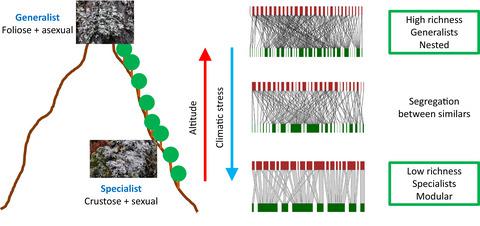Our official English website, www.x-mol.net, welcomes your
feedback! (Note: you will need to create a separate account there.)
Networks of epiphytic lichens and host trees along elevation gradients: Climate change implications in mountain ranges
Journal of Ecology ( IF 5.3 ) Pub Date : 2020-10-29 , DOI: 10.1111/1365-2745.13538 Hugo Saiz 1, 2 , Matteo Dainese 3 , Alessandro Chiarucci 4 , Juri Nascimbene 4
中文翻译:

附生地衣和寄主树沿海拔梯度的网络:山脉对气候变化的影响
更新日期:2020-10-29
Journal of Ecology ( IF 5.3 ) Pub Date : 2020-10-29 , DOI: 10.1111/1365-2745.13538 Hugo Saiz 1, 2 , Matteo Dainese 3 , Alessandro Chiarucci 4 , Juri Nascimbene 4
Affiliation

|
- Several studies have evaluated lichen responses in terms of shifts in species climate suitability, species richness and community composition. In contrast, patterns of co‐occurrence among species that could be related to complex species interactions have received less consideration. Biotic interactions play a major role in shaping species niches, fitness and adaptation to new environments. Therefore, considering the specific relationships among co‐occurring species is essential to further deepen our knowledge of biodiversity response to climate change. In this perspective, the analysis of lichen ecological networks across elevational gradients may provide a powerful tool to understand how communities are structured and how biotic interactions are modulated by changing climatic conditions.
- We evaluated the contribution of environmental and species biological attributes to the structure of epiphytic lichen–host tree networks. Specifically, we studied lichen communities considering two different network levels: the whole lichen community, and groups of lichen species that presented similar biological traits. In this framework, we (a) characterized the structure of the epiphytic lichen–host tree networks; (b) assessed how network structure varied with climate, forest attributes and community trait diversity and (c) evaluated the role that biological traits played in the connections established between co‐occurring lichens.
- On the one hand, results indicate that epiphytic lichen communities are dominated by local segregation, suggesting habitat specialization among lichens within their host tree, and that climatic conditions and, to a lesser extent, lichen diversity are the main drivers of community assemblage. On the other hand, the role of lichen species in the networks depends on their particular biological traits, supporting the hypothesis that biological traits contribute to shape network structure by influencing the ability of the species to interact between each other. These findings warn about the potential impact of climate change on epiphytic lichen communities.
- Synthesis. This study builds towards a better understanding of lichen community assembly and on biodiversity response to climate change in forest alpine ecosystems. In particular, our results highlight the value of lichen–tree networks to inform about assemblage processes acting at different organizational levels and indicate that lichens might become one of the most threatened groups under global change scenarios.
中文翻译:

附生地衣和寄主树沿海拔梯度的网络:山脉对气候变化的影响
- 几项研究已经根据物种气候适宜性,物种丰富度和群落组成的变化评估了地衣的响应。相反,可能与复杂物种相互作用相关的物种间共现模式受到的关注较少。生物相互作用在塑造物种生态位,适应和适应新环境方面起着重要作用。因此,考虑共同存在的物种之间的具体关系对于进一步加深我们对生物多样性对气候变化的响应的认识至关重要。从这个角度来看,跨海拔梯度的地衣生态网络分析可以提供一个强大的工具,以了解社区的结构以及如何通过改变气候条件来调节生物相互作用。
- 我们评估了环境和物种生物学特性对附生地衣-寄主树网络结构的贡献。具体而言,我们考虑了两个不同的网络级别来研究地衣群落:整个地衣群落和表现出相似生物学特性的地衣物种组。在这个框架中,我们(a)表征了附生地衣-寄主树网络的结构;(b)评估了网络结构如何随气候,森林属性和群落特征的多样性而变化,并且(c)评估了生物特征在同时发生的地衣之间建立的联系中所起的作用。
- 一方面,结果表明附生地衣群落以局部隔离为主,表明寄主树中地衣之间的生境专门化,并且气候条件和较小程度的地衣多样性是群落聚集的主要驱动力。另一方面,地衣物种在网络中的作用取决于其特定的生物学特性,支持以下假设:生物学特性通过影响物种之间相互作用的能力而有助于塑造网络结构。这些发现警告了气候变化对附生地衣群落的潜在影响。
- 综合。这项研究的目的是更好地了解地衣群落组装以及森林高山生态系统中生物多样性对气候变化的响应。特别是,我们的结果强调了地衣树网络的价值,该信息可告知在不同组织级别起作用的集合过程,并表明在全球变化情况下,地衣可能成为受威胁最大的群体之一。









































 京公网安备 11010802027423号
京公网安备 11010802027423号